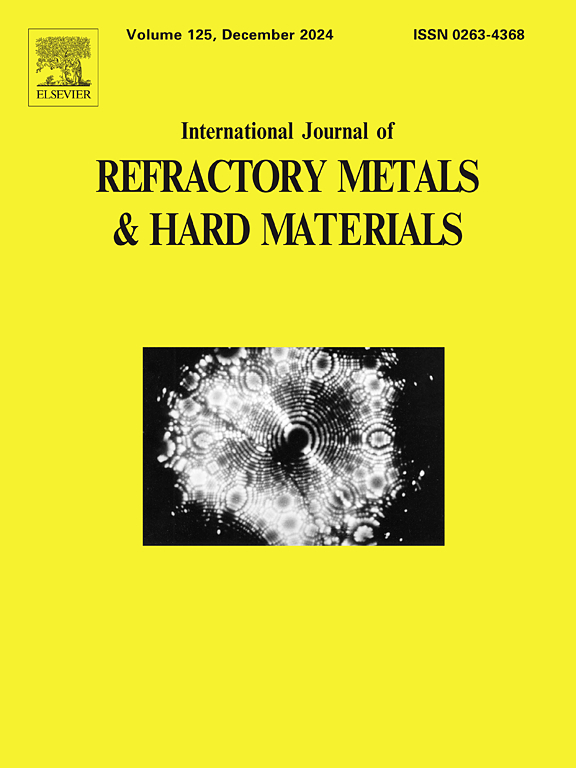Performance characteristics and waste implications of WC materials used as neutron shielding materials in fusion
IF 4.2
2区 材料科学
Q2 MATERIALS SCIENCE, MULTIDISCIPLINARY
International Journal of Refractory Metals & Hard Materials
Pub Date : 2025-06-10
DOI:10.1016/j.ijrmhm.2025.107280
引用次数: 0
Abstract
The nuclear fusion of deuterium and tritium (D-T) produces a high flux of 14 MeV neutrons. While these neutrons are the primary source of energy, they also cause damage to the structural and functional materials of fusion devices. Tungsten carbide (WC), with its excellent neutron attenuation properties and high density, is being proposed as a radiation shield to protect critical components, such as the high temperature superconducting (HTS) magnets used to confine plasmas in a spherical tokamak (ST). Due to its brittle nature, WC needs binder materials, such as cobalt, iron, or iron‑chromium, to form a ductile matrix for the WC grains. These binder materials enhance thermomechanical properties but subsequently contribute to an additional radioactive waste hazard and high decay heat that complicates maintenance and radioactive waste management strategies. In the present work, an evaluation of the neutronics properties of various grades of WC has been conducted, containing cobalt (3 wt% and 6 wt%), iron (2.76 wt%), and iron‑chromium (2 wt%) as binder materials. Additionally, a comparative analysis has been made with predictions for pure WC without any binder materials and impurities. A generic ST model producing 1 GW of fusion power has been implemented in the Monte Carlo N-Particle (MCNP) code, with neutron spectra at varying depths within the centre column shield calculated. These neutron spectra are used in the FISPACT-II code to predict the gas production, displacement per atom (dpa), induced activity, decay dose, and decay heat in various WC grades. This paper examines how different binder materials affect neutron attenuation, gas production, displacements per atom (dpa), and radioactive waste production, including waste categorisation. The choice of binder material has little effect on neutron attenuation, dpa, and helium production. However, it significantly affects hydrogen production, induced activity, and gamma dose rate after shutdown. The paper further discusses the impact of binder materials on the production of intermediate level radioactive waste, as well as the major contributing radionuclides (to activity) that are produced during operation. The paper also compares some crucial mechanical properties – flexural strength, fracture toughness, elastic modulus, grain size, and grain size distribution of these grades at room temperature.
核聚变中用作中子屏蔽材料的碳化钨材料的性能特征及其废物影响
氘和氚的核聚变(D-T)产生14兆电子伏特的高通量中子。虽然这些中子是能量的主要来源,但它们也会对聚变装置的结构和功能材料造成损害。摘要碳化钨(WC)具有优异的中子衰减性能和高密度,可用于保护球形托卡马克(ST)中限制等离子体的高温超导(HTS)磁体等关键部件的辐射屏蔽。由于WC的脆性,它需要结合剂材料,如钴、铁或铁铬,以形成WC晶粒的延展性基体。这些粘结材料增强了热机械性能,但随后增加了放射性废物危害和高衰变热,使维护和放射性废物管理策略复杂化。在本工作中,对含钴(3 wt%和6 wt%)、铁(2.76 wt%)和铁铬(2 wt%)作为粘结剂的不同等级WC的中子电子学性能进行了评价。此外,还对不含粘结剂和杂质的纯WC的预测结果进行了对比分析。在蒙特卡罗n粒子(MCNP)代码中实现了一个产生1gw核聚变功率的通用ST模型,并计算了中心柱屏蔽内不同深度的中子能谱。这些中子谱在FISPACT-II代码中用于预测不同WC等级的产气量、每原子位移(dpa)、诱导活度、衰变剂量和衰变热。本文考察了不同的粘结剂材料如何影响中子衰减、气体产生、每原子位移(dpa)和放射性废物产生,包括废物分类。粘结剂材料的选择对中子衰减、dpa和氦产量影响不大。然而,它会显著影响氢气的产生、诱导活性和关闭后的伽马剂量率。本文进一步讨论了粘合剂材料对产生中间水平放射性废物的影响,以及在运行过程中产生的(对活动的)主要贡献放射性核素。本文还比较了这些牌号在室温下的一些关键力学性能——抗弯强度、断裂韧性、弹性模量、晶粒尺寸和晶粒尺寸分布。
本文章由计算机程序翻译,如有差异,请以英文原文为准。
求助全文
约1分钟内获得全文
求助全文
来源期刊
CiteScore
7.00
自引率
13.90%
发文量
236
审稿时长
35 days
期刊介绍:
The International Journal of Refractory Metals and Hard Materials (IJRMHM) publishes original research articles concerned with all aspects of refractory metals and hard materials. Refractory metals are defined as metals with melting points higher than 1800 °C. These are tungsten, molybdenum, chromium, tantalum, niobium, hafnium, and rhenium, as well as many compounds and alloys based thereupon. Hard materials that are included in the scope of this journal are defined as materials with hardness values higher than 1000 kg/mm2, primarily intended for applications as manufacturing tools or wear resistant components in mechanical systems. Thus they encompass carbides, nitrides and borides of metals, and related compounds. A special focus of this journal is put on the family of hardmetals, which is also known as cemented tungsten carbide, and cermets which are based on titanium carbide and carbonitrides with or without a metal binder. Ceramics and superhard materials including diamond and cubic boron nitride may also be accepted provided the subject material is presented as hard materials as defined above.

 求助内容:
求助内容: 应助结果提醒方式:
应助结果提醒方式:


